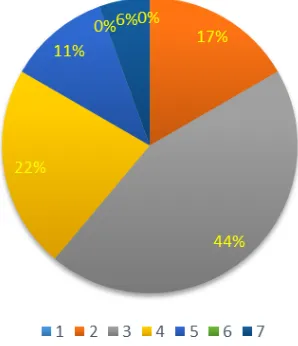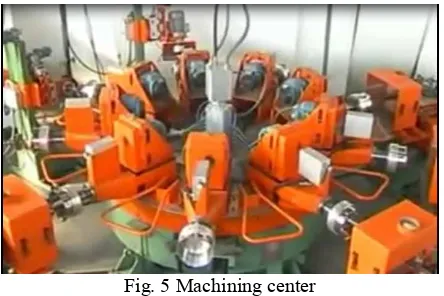Feasibility Study of Machining Center on Small
and Enterprises (SMEs) in Yogyakarta
Andi Sudiarso
#, Wildanul Isnaini
+ #Department of Industrial Engineering Universitas Gadjah Mada, Sleman, DIY Indonesia
ansoed@yahoo.co.uk +
Department of Industrial Engineering Universitas Gadjah Mada, Sleman, DIY Indonesia
wildanulisnaini@mail.ugm.ac.id
Abstract
—
Machining center is used to handle the manufacturing of material feeding using computer numerical control and a lot of various types of equipment and operation. It is needed to improve the productivity rate and has been developed in several countries. But, in Indonesia, there hasn’t been much development of this technology. This paper present the feasibility study of Machining Center on Small and simulation indicate that the installation of machining center could increase the production capacity that are 51% for A type, 88% for B type, and 91% C type. Based on the economic feasibility analysis, the installation of machining center is feasible to implement with PBP for 4.51 years, NPV of Rp 259.561.824, and an IRR of 13%.Key words - machining center, simulation, ProModel, economic feasibility study, SMEs.
I. INTRODUCTION
Machining center is one of technology that has been developing in several countries such as China, Taiwan, and America. Machining center is used to handle the manufacturing of material feeding using computer numerical control and it has a lot of various types of equipments and operations [1]. In common, machining center is a combination from traditional machining consist of drilling machine, turning machine, and milling machine.
In Indonesia, there hasn’t been much development of this technology. On the other hand, Indonesia’s Government through Bappenas [2], is still in an effort to enhance the technological capabilities in small industrial enterprises as well as develop an integrated manner of the dominant sector of small industries. In order to support this program, emerged an idea to develop the machining center for Small and Medium Enterprises (SMEs) in Indonesia. The SMEs consist of craft industry, metal industry, and home industry. From the desire to develop machining center and to support the Bappenas, appeared an idea to evolve machining only 20% can be met by local product. This research consists of technology mapping, rough design and simulation of machining center, and the economic feasibility study.
II. METHODOLOGY
The first step from this research was data collection of technology dissemination of SMEs in Yogyakarta and the data consists of the type and number of machines. It was used for determining the map technology and combination of machining process that will be installed in machining center. This data were also used for determining the feasibility of SMEs as an object research. The object research was determined from production rate and number of employees. SME that has highest production rate and largest number of employees is selected as an object research.
The data collected from that SME were entities, resources, processing time, and transfer time and were used to build the model simulation on ProModel 4.2. An Entitas is something that changed in the system, such as human, parts, customers, or products [3]. While, resource describes a process or sevice entitiy in a queue. The data were collected directly from the SME as an object research.
The next step was to verify and validate the model. The verification was completed with checking the logic and syntax from the model simulation. And, the validation would be determined from two methods: error validation and statistical validation. When the data were completely validated and verified, the design of machining center for object research could be built.
The statistic result of the validated model was used to calculate economic feasibility study to find out the feasibility installation of machining center in that SME. This research used three economic feasibility study criterias to determine the feasibility installation. The criterias are Net Present Value (NPV), Internal Rate of Return (IRR), Pay Back Period (PBP), and Break Even Point (BEP) [4]. Fig. 1 shows the flowchart of the research.
Page 379 of 436
Fig. 1 Research Flowchart
III. RESULTANDDISCUSSION
The purposes of this research are to determine map technology of SMEs in Yogyakarta, to design the machining center for SMEs, to build the model simulation, and to analyse the economic feasibility of machining center installation. Fig. 2 shows the percentage of the number of machinery used by SMEs. The figure shows that most SMEs in Yogyakarta used three kinds of machineries with the percentage of 44%. The machine combination consists of turning, boring, and grinding.
Fig 2. Percentage of Number of Machine
Out of 32 SMEs that observed, X industry is selected because it has the highest production capacity, largest number of employees, and use a lot of machines in production. X industry is one of metal’s SME in Yogyakarta. X Industry has 47 combinations of products but there are three kinds of products that would be the research object, named A, B, and C. This products is selected because have the highest production rate based on Pareto.
The data taken from X Industry include locations, entities, resources, processing time, and transfer time. Fig. 3 shows the Operation Process Chart (OPC) from those products.
Fig. 3 Operation Process Chart (OPC)
From the OPC, information of processing time and kinds of workstations can be gotten. Using the OPC and the data collected, the simulation model is generated on ProModel 4.2. The simulation is adapted to the real conditions of X industry. Fig. 4 shows the layout of model simulation.
Fig. 4 Layout Simulation
The model simulation needs to be verified and validated. Verification can be done from checking the logic and syntax by the expert. This research has two experts to do verifiation: ProModel 4.2 expert and production manager from X industry.
Then, after model simulation is verified, validiation needs to do. Model validation divided into two ways: calculate the error between actual and model simulation and hypothesis testing with statistic. The error calculation shows that the difference between the actual and simulation ranged from 0% to 3%. This error percentage is still relatively small. Statistical validation is completed with sign test non parametric method to see the significance using Minitab 15 software. The result shows that the model has been validated because the p value
from all workstation are more than α. So, Ho is accepted or
there is no significant difference between simulated and actual models.
Page 380 of 436
The model simulation that has been verified and validated is used for building the design of machining center. The design is adopted from the existing machining center for pots production. Fig. 5 shows the existing model of machining center.
Fig. 5 Machining center
Time of loading, unloading, and setup are adopted from that model because the model has the identical processess with X industry. This research proposes machining center design that is integrated by computer and able to work on 3 products simultaneously adopted from Fig. 5.
Fig. 6 shows the design of machining center for X Industry. This machine requires three operators to handle the loading and unloading process.
Fig. 6 Machining Center Design
The machine has six workstations consists of three polishing machines and three turning machines. One product is finished by one turning machine and one polishing machine.
The installation of machining center design can improve the production rate significantly more than 50%. The result of simulation indicate that the installation of machining center could increase the production capacity that are 51% for A type, 88% for B type, and 91%C type. From that result, it means that the installation of machining center is worked. Then, this result must be analysed with economic study to know the installation is feasible in economic or not. The Criteria of Economic feasibility analysis are Net Present
Value (NPV), Payback Period (PBP), Internal Rate of Return (IRR), and Break Even Point (BEP). The economic feasibility can be determined from the NPV and the IRR. When the NPV is positive, the installation is feasible. If the percentage of IRR larger than the percentage of MARR, so the installation is feasible. In this research used 10,5% of MARR. Based on it, the installation of machining center is feasible to implement with PBP for 4.51 years, NPV of Rp 259.561.824, an IRR of 13%, BEP of 88.900 units for WB type, BEP of 13.569 for WD type, and 34.756 for WC type.
Another economic analysis is needed to compare the investment of machining center (midway option) to the existing condition (initial choice). This analysis is done to determine wether the midway option is better or not. Table 1 shows the replacement analysis result.
TABLE 1
REPLACEMENT ANALYSIS
Initial Choice Midway Option (Machining Center)
Initial Investment Rp17.378.005
Labor Cost Rp14.981.250 Rp10.500.000 Overhead Cost Rp66.146.387 Rp22.464.000
TOTAL Rp81.127.637 Rp32.964.000
Based on the replacement analysis, the cost of midway option is lower than initial choice with the difference of Rp 48.163.637. So, it is feasible to replace the exsisting machines with the machining center.
IV. CONCLUSIONS
The observed metals SMEs show that the
most-used machine for machining process are drilling,
grinding, and turning. The highest number of machine
combinations is 3 with the percentage of 44%. This
combinations consists of turning, drilling, and grinding.
The concept of machining center consists of six process,
which are three polishing process and three turning
process. All of this process are incorporated in the
machining center that is integrated with computer
(CNC). The result of the simulation indicate that the
installation of machining center can increase the
production capacity that are 51% for A type, 88% for B
type, and 91%
C type. And. based on the economic
feasibility analysis, the installation of machining center
is feasible to implement with PBP for 4.51 years, NPV
of Rp 259.561.824, and an IRR of 13%.
REFERENCES
[1] Ryerson, McG.H., Dictionary of Scientific and Technical Terms, 6th ed., published by The McGraw-Hill Companies Inc, New York, 2003. [2] Bappenas, Pembangunan Daerah Tingkat 1, Bappenas, Daerah Istimewa
Yogyakarta, 2013
[3] Pegden, D.C., Shannon, R.E., and Sadowski, R.P., Introduction to Simulation Using Siman, 2nd ed., McGraw-Hill, New York, 1995. [4] Soeharto, I., Studi Kelayakan Proyek Industri, Erlangga, Jakarta, 2002.

